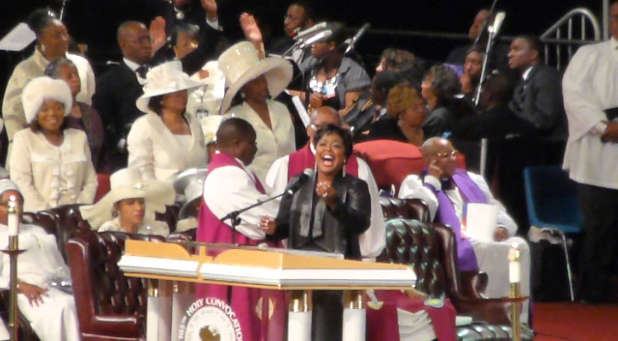Notable History: The Quiet Rise of Black Pentecostals
Note: This article appeared in the June 1986 issue of Charisma magazine. According to blackpast.org, the Church of God in Christ’s membership has risen to over five million members in the U.S. and it has become one of the world’s largest Pentecostal churches.
Many people think the Assemblies of God is the largest Pentecostal denomination in the United States. It is also commonly thought that the oldest Pentecostal denomination in the nation is the Church of God, headquartered in Cleveland, Tennessee.
It just may be, however, that the nation’s largest and oldest Pentecostal group is “none of the above,” but rather the mostly black church known as the Church of God in Christ with headquarters in Memphis, Tennessee.
Chartered in 1897, the Church of God in Christ is unquestionably the first legally chartered body among the American Pentecostal denominations. And with a claimed membership that exceeds three million persons, this church is twice the size of the Assemblies of God in the United States. It is also one of the fastest-growing Pentecostal movements in the world.
The roots of the Church of God in Christ lie deep in the late 19th-century Holiness movement in the Southern states. These roots are also grounded in the culture and history of the American blacks. The story of this church in its early years was also largely the biographies of two prominent church leaders, C.P. Jones and C.H. Mason.
Charles Harrison Mason, born in 1866 in Bartlett, Tennessee, was the son of former slaves. He grew up in a Missionary Baptist Church and as a young man felt the call to preach. In 1892 he entered Arkansas Baptist College to study for the ministry, but was soon grieved by the liberal teachings he heard. He left school after only three months because he felt that “there was no salvation in schools or colleges.” In 1895, while on a visit to Jackson, Mississippi, he met another young Baptist preacher who was to greatly affect his life: Charles Price Jones. Jones was serving as pastor of the University Church in Selma, Alabama.
Later that year, Jones and Mason traveled to Lexington, Mississippi, where they came into contact with believers who adhered to Holiness doctrines. They taught the Wesleyan view of entire sanctification as a second work of grace. Joining in Holiness revivals in local Baptist churches, the two fiery preachers were soon disfellowshipped and forbidden to preach in the churches of the local Baptist Association. They thereupon opened a historic revival campaign in a cotton mill in Lexington in February 1896. This was to become the first local congregation of the new denomination.
The name for the group came to Mason in March 1897 while walking the streets of Little Rock, Arkansas. “The Church of God in Christ” seemed to be a biblical name for the new Holiness church in Lexington. The teachings of the new group were the typical perfectionistic doctrines of the turn-of-the-century Holiness movement. Those receiving the sanctification experience were thenceforth holy and known as “saints.”
These Holiness people neither smoked tobacco nor drank alcohol. They dressed modestly, worked hard and paid their bills. They fervently praised the Lord with shouting and dancing in the Spirit. Among them the poorest sharecropper could become a preacher of the gospel and even a bishop in the church.
In 1897, the Church of God in Christ was legally chartered in nearby Memphis, Tennessee, becoming the first Pentecostal church in America to obtain such recognition. After this, Memphis became the headquarters of the church and the site of the annual convocations, which became huge rallies for the faithful.
For several years the church continued peacefully with dual leadership. Though Jones was the leader of the church, Mason was the dominant personality. They were a fine and harmonious team. Mason was known for his godly character and preaching ability, while Jones was known for his hymns, many of which became popular throughout the nation.
The tranquility between Mason and Jones broke in 1906 when word reached Memphis of the new Pentecostal revival in Los Angeles in a little mission on Azusa Street. The pastor of the mission was a black man, William J. Seymour, who preached that the saints, although sanctified, had not received the “baptism in the Holy Ghost” until they had spoken in tongues as the “initial evidence.” It was said that all the gifts of the Spirit were being restored to the church at Azusa Street.
The news from Azusa Street met with a divided response in the Church of God in Christ which by now had spread widely into Tennessee, Mississippi and Arkansas. Jones was cool to the new teaching while Mason was eager to travel to Los Angeles to investigate. For years Mason had claimed that “God endowed him with supernatural characteristics, which were manifested in dreams and visions.” In March of 1907, Mason persuaded two fellow leaders, J.A. Jeter and D.J. Young, to accompany him on a pilgrimage to Azusa Street.
What they saw was powerful and convincing. In the words of Frank Bartleman, “the color line was washed away by the Blood.” People of all races and nationalities worshipped together in striking unity and equality. The gift of tongues was matched by other gifts such as interpretation, healing, exorcism of demons, and words of knowledge and wisdom. In a short time Mason, Jeter and Young received the “baptism,” spoke in tongues and returned to Memphis eager to share their new experience with the entire church.
When they arrived, they found that another Azusa Street “pilgrim,” Glen A. Cook, a white man, had already visited the church and preached the new Pentecostal doctrine. Many members had accepted the message and were speaking in tongues “as the Spirit gave them utterance.” Everyone did not accept Cook’s message, however. This included C.P. Jones, who in 1907 was serving as the general overseer and presiding elder of the denomination.
A struggle for the future of the church ensued as the new “Pentecostal” party led by Mason vied with Jones for the leadership. By August 1907, the issue came to a head when the General Assembly met in Jackson, Mississippi. After a “very lengthy discussion” which lasted three days and into the nights, the assembly withdrew “the right hand of fellowship” from C.H. Mason and the Pentecostal faction. When Mason left the assembly, about half of the ministers and laity exited with him.
Late in 1907, the Pentecostal faction called its own convocation in Memphis. The Church of God in Christ name was retained and a “Pentecostal” statement was added to the articles of faith, which separated the “baptism” in the Holy Spirit from the experience of sanctification. It stated that “the full baptism in the Holy Spirit was evidenced by speaking in other tongues.”
Although tongues were thus welcomed and accepted in the church, other manifestations of the Spirit’s presence were also commonly seen as “evidence” of the indwelling Holy Spirit, such as shouting and “dancing in the Spirit.”
After 1907, a lengthy legal struggle ensued over who could use the name and charter of the Church of God in Christ. The followers of Mason or the followers of Jones were each using the name. The issue was finally settled in 1909 when the courts of Shelby County, Tennessee, awarded victory to Mason and his Pentecostal party. They therefore continued to use the name and charter of the Church of God in Christ, while Jones and his non-Pentecostal followers separated to form a new group which they named the Church of Christ (Holiness) U.S.A.
From its base in Memphis, the Church of God in Christ spread rapidly over the United States. Its first growth area was in the South, where, like a prairie fire, the Pentecostal revival swept through many black neighborhoods. Mason often organized churches by preaching in the streets. As the Pentecostal movement spread among whites in the South, Mason occasionally visited these churches and was recognized as an outstanding leader.
In 1921, he met again with William J. Seymour in New Jersey, where the two black Pentecostal apostles talked about the old “Azusa days.” Although the two leaders were not in the same denomination, they remained lifelong friends.
As his church grew, Mason began to demonstrate his organizing genius. Each “diocese” was led by a bishop that usually served for life. Jurisdictions were divided and subdivided as the church grew so that the church spread into every state by the end of World War II.
From 1910 to 1916, Mason began four major departments that aided in the growth of the church. They were the women’s department, the Sunday school, the “Young People’s Willing Workers” (YPWW), and the home and foreign missions department.
The teachings of the church were also defined in the early years. Basically a Holiness church, the denomination continued to teach an experience and life of holiness as the ultimate goal of the Christian life. To this was added the Pentecostal baptism with the Holy Spirit, which brought in the life of the church all the gifts of the Spirit. When the controversy over the existence of the trinity erupted in the Pentecostal world after 1912, the church of God in Christ remained staunchly trinitarian. Added to the sacraments of water baptism and the Lord’s Supper was the “ordinance” of “feet washing.”
A major early teaching of the church was pacifism, the belief that Christians should not engage in war. Because of his immovable stand on this issue, Mason was jailed in 1918 in Lexington, Mississippi, because he forbade his followers to serve in the armed forces. While he was imprisoned, a storm blew the roof off the courthouse building. The magistrates released him the next day.
Throughout his life, Mason was hounded for his pacifist views, even to the point that the FBI kept a file on his activities. Like most of the other Pentecostal bodies in the United States, however, the Church of God in Christ softened this stand during World War II because of the apparent evils of fascism and Nazism.
Mason never accepted the separation of Christians on the basis of race. He never openly fought the Jim Crow system of racial segregation, but opposed the racial separations among the Pentecostals that came after the halcyon days of Azusa Street. Indeed, for many years Mason’s church was the most integrated denomination in the United States.
In one of the most racist periods of American history, (1890-1924) the Pentecostals stood out as a radiant exception to the segregation of the times.
In fact, hundreds of white Pentecostal preachers were ordained by Mason and were given ministerial credentials from the Church of God in Christ in the years before World War I. One reason was that the Church of God in Christ was the only incorporated Pentecostal denomination in the nation for many years. In order for a minister to be bonded for performing marriages, to be deferred from the draft or to obtain clergy permits on the railroads, he had to demonstrate that he was a minister of a recognized religious body. Mason’s church had the prized incorporation charter which made it attractive for hundreds of white ministers to join.
As time went on, some white pastors began to hold separate Bible conferences while keeping their relationship with Mason intact. Finally a gentleman’s agreement was struck whereby the whites could issue credentials in Mason’s name and that of the Church of God in Christ, the only stipulation being that no credentials would be given to anyone who was “unworthy.”
Just before the beginning of World War I, a large group of white Pentecostal ministers became dissatisfied with this arrangement and began moves to organize a new denomination that could also be chartered. Thus, the Assemblies of God was born. Most of the founders of the Assemblies of God who gathered in Hot Springs, Arkansas, in April 1914 carried credentials with the Church of God in Christ. Although Mason and his group were nominally invited to attend the Hot Springs conclave, no letters of invitation were sent to the black ministers.
Mason did attend the meeting, however, and was invited to preach on the Thursday night of the convention. His choir sang a special number after which the venerable bishop preached a sermon on the wonders of God as seen in the lowly sweet potato. Despite Mason’s appearance, the Assemblies of God organized a largely white denomination, which soon became the largest Pentecostal church in the country. Thus the organization of the Assemblies of God was at least partially a racial separation from Mason’s church.
After 1914, the leaders of the white Pentecostal denominations looked on the Church of God in Christ as the black Pentecostal movement for the United States. Black converts in white churches were encouraged to join the Church of God in Christ.
Some of the church’s greatest growth came in the years following World Wars I and II, when blacks migrated en masse to the large industrial cities of the North. Millions of Southern blacks moved to New York City, Detroit, Philadelphia, Chicago, Boston, Los Angeles and other urban centers to escape the agrarian poverty that still blighted much of the South.
These migrants brought their churches with them. Many of these were members of the Church of God in Christ. Often they settled in storefront buildings or bought the elegant church buildings sold by whites who fled the inner cities for the suburbs.
The Pentecostal churches proved to be the most successful in serving this mass of humanity who crowded into the urban ghettos. In some cities almost every block boasted a Church of God in Christ—in many cases humble and unostentatious, but nevertheless a strong redemptive force in the neighborhood. The story of one of these urban migrant churches was powerfully portrayed in James Baldwin’s book Go Tell It On the Mountain, which was an autobiographical account of his childhood in a storefront Pentecostal church in Harlem.
At the time of Mason’s death in 1961, his church had about 400,000 members in the United States. This compared favorably with the record of John Wesley, who counted 100,000 Methodist followers when he died in 1791. Before his death, Mason had constructed the massive Mason Temple in Memphis where the faithful gathered annually for the great convocations. This temple, which seats almost 10,000, was unable to hold the convocation crowds, which annually attracted about 40,000 persons. After he died at the age of 95, the church was given permission to bury Mason in the lobby of the temple, the only person so honored in the history of the city.
After Mason’s death, a power struggle erupted over who would inherit the mantle of leadership. The temporary winner was Bishop O. T. Jones Sr., who served as senior bishop from 1962 to 1968. But in the end, it was Bishop Mason’s son-in-law, J.O. Patterson, who took command. Elected to lead the church in November of 1968, Patterson was given the title of presiding bishop. He has since led the church to its greatest growth and development. Despite a schism in 1969 in which 14 Church of God in Christ bishops formed the Church of God in Christ, International (now claiming 200,000 members), the church has continued to grow rapidly.
In 1964, a census was taken which reported 425,000 members in 4,100 congregations. The next census was not attempted until 1982. As a result of that count, the Yearbook of American and Canadian Churches reported an American membership for the church at 3,709,861 persons in 9,982 congregations. This is one of the most explosive records of church growth in the history of the United States. These figures indicate that the Church of God in Christ is the second largest black organization in America, exceeded only by the National Baptist Convention.
Although the Church of God in Christ did not play a major role in the black civil rights movements of the 1950s and 1960s, many Church of God in Christ ministers and members stood at the side of Martin Luther King Jr. in his nonviolent crusade for equal rights. In fact it was in Memphis’ Mason Temple that King preached his famous “I have been to the Mountain” message. This, his last sermon, was delivered the night before his assassination.
In recent years, the charismatic movement has been conspicuous for its apparent lack of success with blacks in the mainline churches. But the Pentecostal movement has positively flourished in the predominantly black Church of God in Christ. In the last decades of the 20th century, Patterson’s fast-growing church continues to serve as “a haven for the masses.”






































